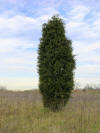WILD
FOODIES' HOME PAGE
PLANT PROFILE LIST
NAME: Juniper
SPECIES / FAMILY: Juniperus Virginiana / Cupressaceae
OTHER COMMON NAME(S): Pencil Cedar, Silver East, Red cedar, Silver Cedar – Despite these names, a juniper is not a cedar.(2)
CONDITIONS:
sun-partial shade
|
PARTS: |
EDIBLE |
TASTE |
RAW/COOK |
SEASON |
|
All |
|
|
|
|
|
Shoots |
|
|
|
|
|
Leaves |
||||
|
Stalk/Stem |
|
|
|
|
|
Buds |
||||
|
Flowers |
|
|
|
|
|
Fruits / Cones |
|
gin |
RAW/COOK |
Fall |
|
Pods |
|
|||
|
Seeds |
|
|
|
|
|
Nuts |
|
|
|
|
|
Roots |
|
|
|
|
|
Bark |
|
|
|
|
PORTION: very small
COMMENT:
Fruit/berry/cone
- raw or cooked. A sweetish resinous flesh. They can be crushed and used as a
flavouring in soups and stews.(1)
The berries are not berries. They are modified
cones.
The berries/cones are employed for flavoring, most notably in gin and the French
liqueur Chartreuse. It takes the “berries” two to three years to ripen.
Mature but still green berries are used to flavor gin. Mature blue berries are
used to flavor game. They are also used to flavor stuffing, marinades and
stews. In Europe one cannot make authentic sauerbraten or sauerkraut without
juniper berries. In the southern Alps a dark syrup is made from the berries and
is traditionally eaten as a dessert with cream or hot milk. Some berries are as
much as 30% sugar.(2) For more specific preparations:
http://www.eattheweeds.com/junipers
CAUTION: All parts of plant are toxic, including berries/cones if consumed in quantity.(1) As with many herbs used medicinally or as a spice juniper berries should be used sparingly. Think flavoring, not food. They irritate the kidneys and are diuretic. Juniper extracts should be avoided(2).
Also to be avoided entirely are J. sabina and J. oxycedrus, both from southern Europe. J. sabina is often planted as an ornamental in the United States. Small junipers used in landscaping might be of European origin and not useable in any way. Make sure of their identification.(2)
Junipers can also cause Cedar Apple Rust Disease which damages both Cedars and yjr fruit of Apples, Crabapples, Hawthorn, Quince, and Juneberries. https://www.fs.fed.us/wildflowers/plant-of-the-week/gymnosporangium_juniperi-virginianae.shtml
NUTRITION/MEDICINAL: Abortifacient; Anthelmintic; Antiseptic; Aromatherapy; Cancer; Diaphoretic; Diuretic; Emmenagogue; Rubefacient; Stimulant.(1) Junipers do have the potent antiviral compound deoxypodophyllotoxin (DPT) which has been shown to be effective against viruses that cause the flu and herpes. So maybe juniper tea did have some effect on the intensity or duration of the measles. The DPT is found in berries and the leaves, aka needles. (2) Also: https://draxe.com/juniper-berry-essential-oil
LOOK-A-LIKES:
POISONOUS LOOK-A-LIKES:
OTHER USES: Essential; Incense; Insecticide; Repellent; Shelterbelt; Tinder; Wood.(1) During the Dust Bowl drought of the 1930s, the Prairie States Forest Project encouraged farmers to plant shelterbelts (wind breaks) made of eastern juniper throughout the Great Plains. They thrive under adverse conditions – both drought tolerant and cold tolerant, they grow well in rocky, sandy, and clay substrates. Competition between trees is minimal, so they can be planted in tightly spaced rows, and the trees still grow to full height, creating a solid windbreak in a short time.(3)
SOURCE LINKS (may include nutritional and medicinal info, plus other uses):
- https://pfaf.org/user/Plant.aspx?LatinName=Juniperus+virginiana
- http://www.eattheweeds.com/junipers
- https://en.wikipedia.org/wiki/Juniperus_virginiana
- https://www.brit.co/juniper-berries-recipes (recipes)
- https://www.npr.org/2013/06/14/191321488/whats-a-juniper-berry-and-how-do-i-cook-with-it (recipes)
- https://www.theguardian.com/lifeandstyle/2011/nov/04/juniper-recipes-hugh-fearnley-whittingstall (recipes)
- https://www.growforagecookferment.com/foraging-for-juniper-berries (recipes)
- https://www.seriouseats.com/2014/01/foraged-flavor-all-about-wild-juniper.html (recipes)
- https://www.healingharvesthomestead.com/home/2018/3/4/foraging-for-juniper-berriesand-what-to-do-with-them-youll-be-amazed-at-what-these-little-blue-purple-berries-can-do (recipes +)



_small.jpg)